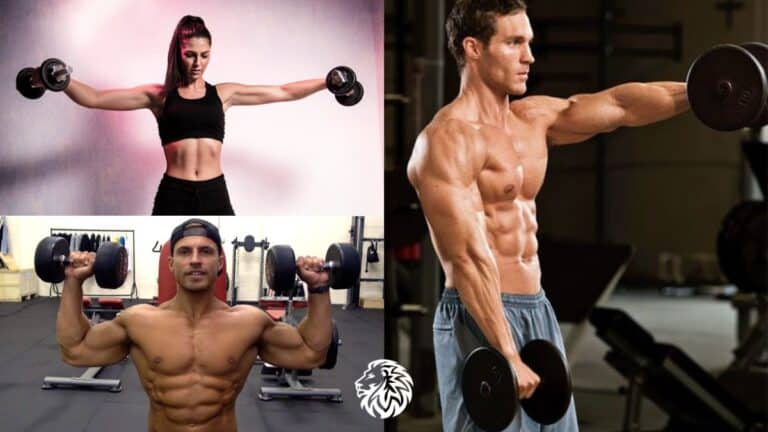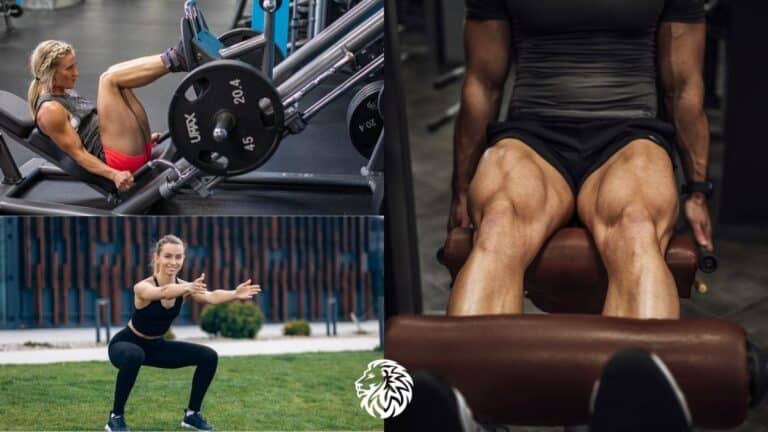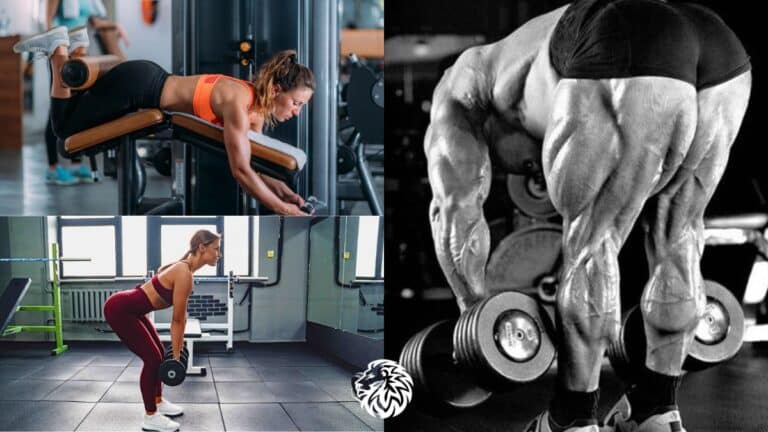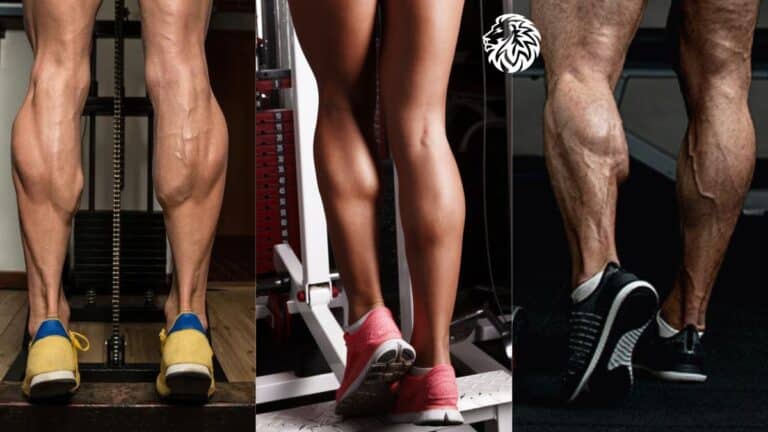Triceps, the often underrated muscles located at the back of the upper arms, play a pivotal role in defining arm strength and aesthetics. While biceps often steal the spotlight in arm development, triceps actually make up a larger portion of the arm’s muscle mass. Their development is crucial for achieving a balanced, toned appearance. Triceps are not just about looks; they are key players in pushing movements, contributing significantly to overall upper body strength.
Engaging in targeted triceps exercises is essential for comprehensive muscle building. These exercises not only increase the size and strength of the triceps but also aid in improving the functionality of the arms for various sports and daily activities. Training the triceps is not just about isolation; it’s about integrating them into the broader context of upper body strength. Properly executed triceps workouts can lead to improved performance in compound movements, better shoulder stability, and enhanced endurance, all while contributing to the coveted sculpted arm appearance.
Anatomy of the Triceps
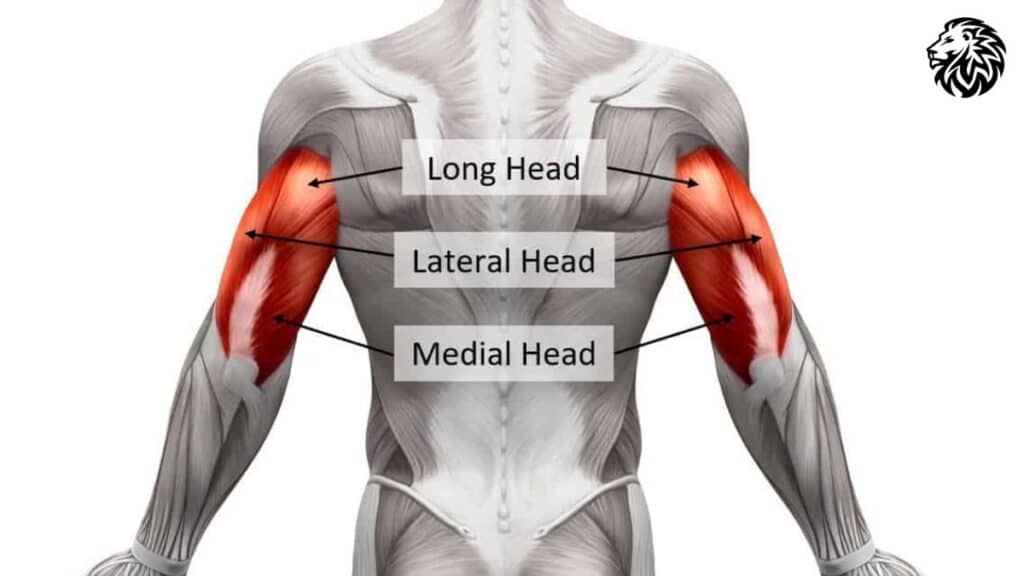
Description of the Triceps Muscle
The triceps brachii, commonly known as the triceps, is a three-headed muscle located at the back of the upper arm. These three heads — the long, medial, and lateral heads — originate from different parts of the arm and shoulder and converge into a single tendon that attaches to the elbow. The long head originates from the scapula (shoulder blade), while the medial and lateral heads arise from the humerus (upper arm bone). This unique structure allows the triceps to perform a range of functions beyond just extending the forearm at the elbow joint.
Functions of the Triceps
The primary function of the triceps is to extend the elbow, straightening the arm. This movement is fundamental in various pushing activities, from everyday tasks like pushing open a door to sports-specific movements like throwing a ball. Additionally, the long head of the triceps assists with the adduction and extension of the arm at the shoulder joint, contributing to movements that bring the arm towards or away from the body.
Effective Targeting of Triceps Muscle Groups
To effectively target the triceps, it’s important to engage in exercises that challenge all three heads of the muscle. Different exercises will place varying degrees of emphasis on each head. For instance, movements involving arm extension above the head tend to engage the long head more intensely, while exercises where the arms are by the sides or in front of the body predominantly work the medial and lateral heads. Understanding this anatomy helps in designing a well-rounded triceps workout routine that ensures balanced development and prevents muscle imbalances. By incorporating a variety of movements, one can effectively stimulate all parts of the triceps, leading to optimal muscle growth and functional strength.
10 Best Triceps Exercises for Building Muscle
Exercise 1: Close-Grip Bench Press
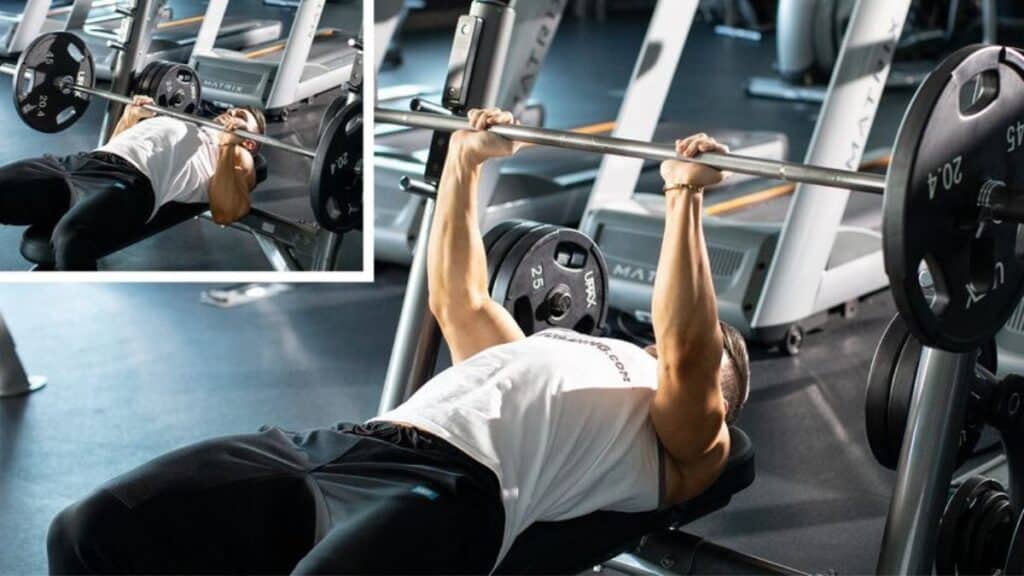
Technique and Form
The Close-Grip Bench Press is a variation of the classic bench press, focusing more on the triceps. To perform it:
- Starting Position: Lie flat on a bench, feet firmly on the ground. Grip the barbell with hands closer than shoulder-width apart.
- Lift Off: Unrack the barbell, holding it straight over your chest with arms fully extended.
- Lowering the Bar: Slowly lower the bar towards the lower part of your chest, keeping your elbows close to your body. This elbow position is key to targeting the triceps.
- Press Up: Push the bar back to the starting position, focusing on using your triceps to drive the movement.
It’s essential to maintain a controlled motion and avoid letting your elbows flare out. Keep your wrists straight and your back slightly arched, with your shoulder blades retracted for stability.
Benefits for Triceps Development
The Close-Grip Bench Press is highly effective for triceps development for several reasons:
- Targeted Muscle Activation: The closer grip shifts the emphasis from the chest and shoulders to the triceps, providing intense triceps activation.
- Compound Movement: It’s a compound exercise that not only strengthens the triceps but also engages the chest and shoulders, offering more comprehensive upper body development.
- Strength and Size Gains: This exercise allows for the use of heavier weights compared to isolation exercises, which can lead to significant strength and muscle size gains in the triceps.
- Versatility: It can be easily incorporated into various workout routines and adjusted for different skill levels by varying the weight.
Incorporating the Close-Grip Bench Press into your routine can significantly enhance triceps strength and contribute to a more balanced and powerful upper body.
Exercise 2: Tricep Dips
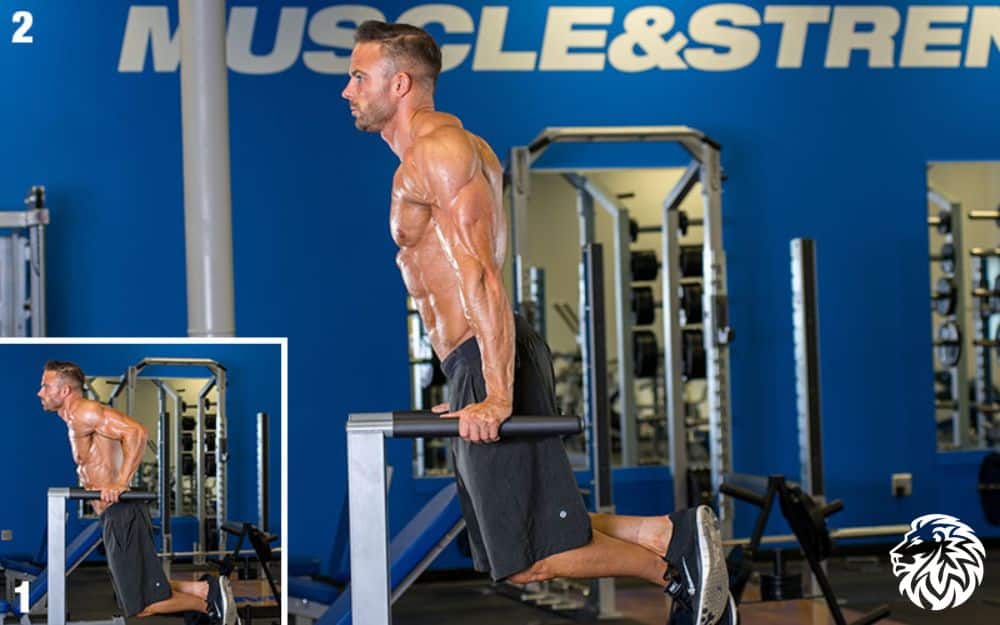
Step-by-Step Guide
Tricep Dips are a versatile bodyweight exercise that targets the triceps effectively. Here’s how to perform them:
- Starting Position: Position yourself between parallel bars or on a dip station. Grip the bars firmly and hoist yourself up until your arms are fully extended.
- Lowering Phase: Slowly lower your body by bending your elbows, keeping them close to your body. Your torso should remain upright, and elbows should point straight back, not outwards.
- Descending Depth: Lower yourself until your elbows form a 90-degree angle or slightly less, depending on your shoulder flexibility and comfort.
- Lifting Phase: Push back up through your palms, extending your elbows to return to the starting position. Focus on using your triceps to drive the movement.
Remember to keep your shoulders down and away from your ears throughout the exercise to avoid strain.
Variations for Different Difficulty Levels
- Bench Dips (Beginner): Sit on the edge of a bench or chair, hands next to your hips. Move your feet out and lower your body off the bench, using your arms to control the movement.
- Straight-Leg Dips (Intermediate): Increase the difficulty of bench dips by straightening your legs out in front of you.
- Weighted Dips (Advanced): For an extra challenge, add weight using a dip belt, weighted vest, or by holding a dumbbell between your feet.
- Assisted Dips (for Beginners or Those with Limited Strength): Use an assisted dip machine or resistance bands to support some of your weight while performing the dip on parallel bars.
These variations allow individuals at different fitness levels to incorporate tricep dips into their workout routines, progressively increasing the difficulty as their strength improves.
Exercise 3: Skull Crushers
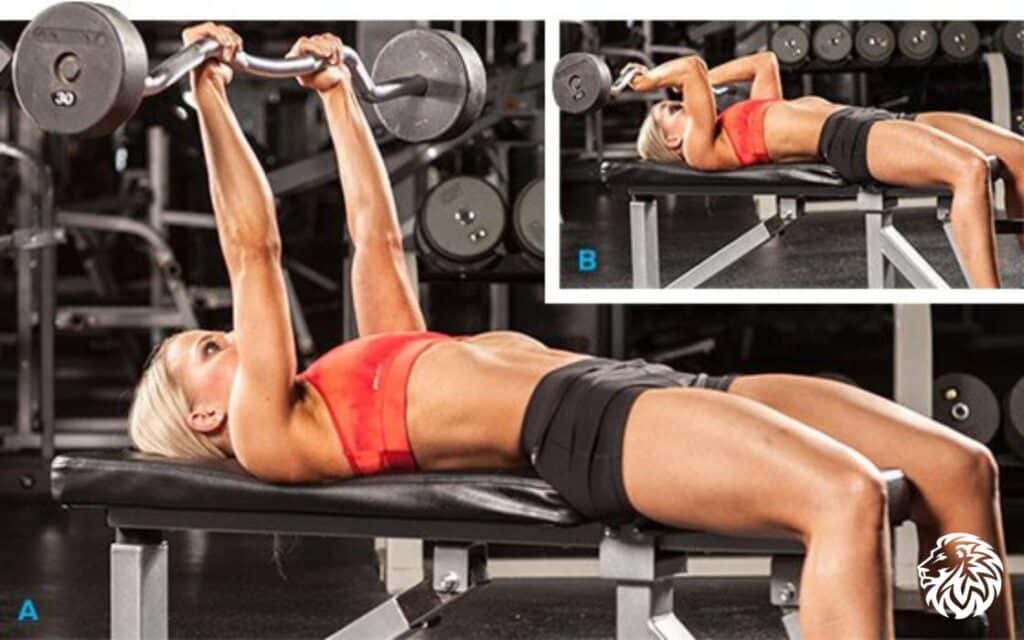
Proper Execution
Skull Crushers, also known as Lying Triceps Extensions, are a popular exercise for triceps development. Here’s how to execute them properly:
- Starting Position: Lie flat on a bench with a barbell or EZ curl bar. Grip the bar with hands shoulder-width apart and extend your arms straight up over your chest.
- Lowering the Bar: Slowly bend your elbows to lower the bar towards your forehead. Keep your upper arms stationary and elbows pointed straight up – only your forearms should move.
- Bar Position: Bring the bar down just above your forehead or towards the bench behind your head for a deeper stretch, depending on your comfort and shoulder flexibility.
- Extension: Extend your arms back to the starting position, focusing on using your triceps to lift the weight.
Maintain control throughout the movement to avoid injury, especially when bringing the bar towards your head.
Safety Tips
- Controlled Movements: Always move the bar in a slow, controlled manner to reduce the risk of hitting your head.
- Elbow Position: Keep your elbows in line and avoid letting them flare out to the sides.
- Start Light: Begin with a lighter weight to perfect your form before progressing to heavier weights.
- Spotter Assistance: If using heavier weights, it’s advisable to have a spotter for safety.
Equipment Needed
- Barbell or EZ Curl Bar: An EZ curl bar is often preferred as it provides a more comfortable grip angle.
- Weights: Depending on your strength and experience, add appropriate weight plates to the bar.
- Bench: A flat bench is needed to lie on during the exercise.
- Collars or Clips: Ensure the weights are secured on the bar with collars or clips for safety.
This exercise is a staple in triceps training due to its effectiveness in isolating and building the triceps muscle. Proper execution and adherence to safety guidelines are key for getting the most out of Skull Crushers.
Exercise 4: Overhead Tricep Extension
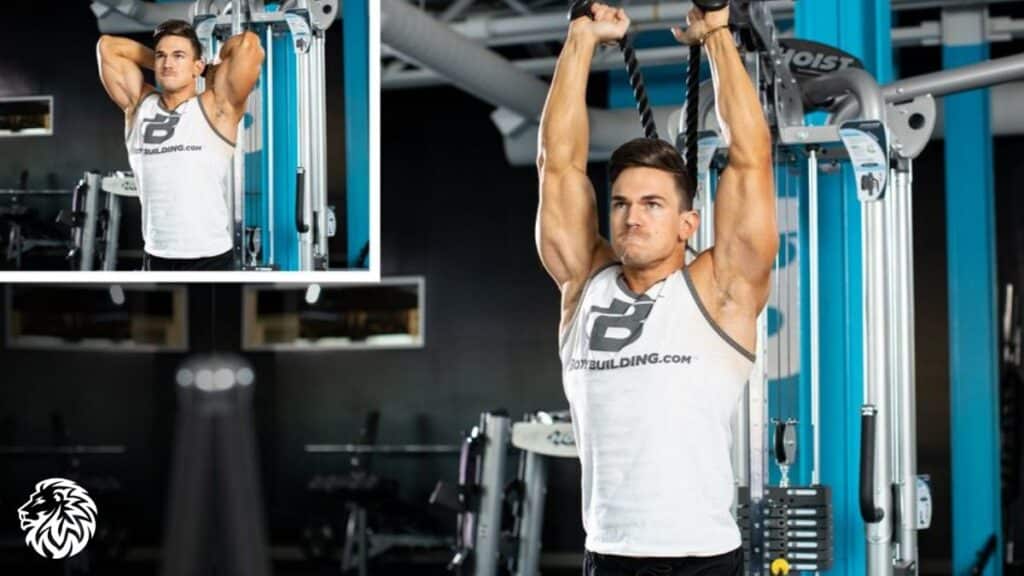
Performing with Dumbbells
- Starting Position: Stand or sit with a dumbbell held in both hands. Extend your arms overhead, keeping your elbows close to your ears.
- Extension: Slowly bend your elbows to lower the dumbbell behind your head. The movement should be controlled and elbows pointing straight up.
- Lift: Extend your arms back to the starting position, focusing on contracting your triceps.
- Stance: Ensure your feet are shoulder-width apart for stability if standing. If sitting, sit upright with your back straight.
Performing with a Cable Machine
- Setting Up: Attach a rope handle to the high pulley of a cable station. Grip the handle with both hands and face away from the machine.
- Extension: Step forward and lean slightly forward. Extend your arms overhead and bend your elbows to lower your hands behind your head.
- Lift: Extend your arms back to the starting position, using your triceps to pull the rope.
- Posture: Keep your core engaged and maintain a slight forward lean throughout the exercise for stability.
Common Mistakes to Avoid
- Flaring Elbows: Keep your elbows close to your head. Allowing them to flare out reduces the effectiveness of the exercise on the triceps.
- Using Too Much Weight: Starting with a weight that’s too heavy can lead to poor form and increase the risk of injury. Begin with a lighter weight and focus on proper technique.
- Lack of Control: Avoid fast, jerky movements. The lowering and lifting phases should be slow and controlled.
- Improper Posture: Maintain a straight back and engaged core. Slouching or leaning too much can put undue stress on your back.
- Overextending the Neck: Keep your neck in a neutral position. Overextending or straining your neck can lead to discomfort or injury.
The Overhead Tricep Extension, whether performed with dumbbells or a cable machine, is an excellent exercise for targeting the long head of the triceps. By avoiding common mistakes and focusing on proper form, this exercise can significantly contribute to building stronger, more defined triceps.
Exercise 5: Diamond Push-Ups
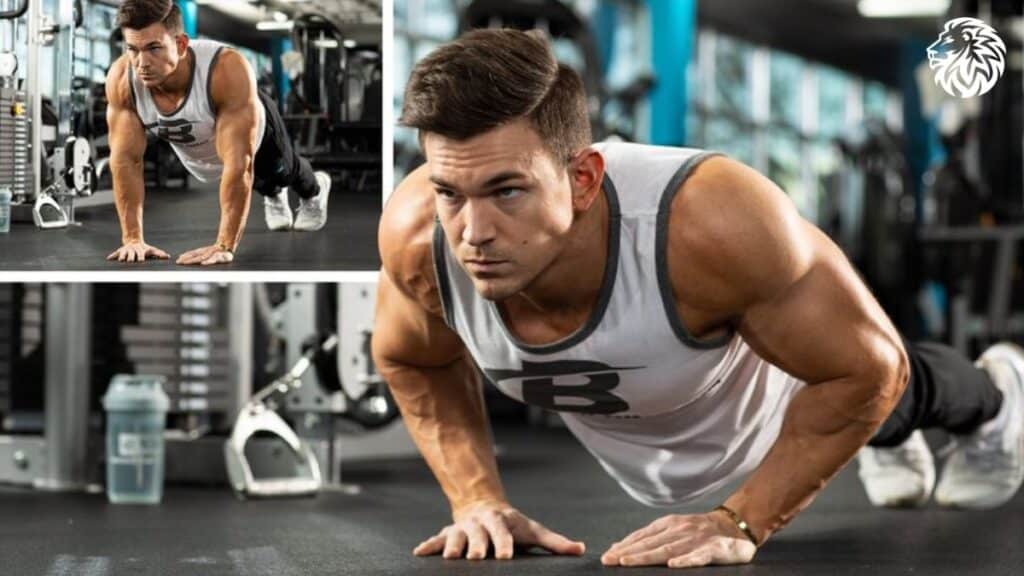
Instructions and Form
Diamond Push-Ups are a challenging variation of the classic push-up that specifically targets the triceps.
- Starting Position: Begin in a standard push-up position but with your hands together under your chest. Position your thumbs and index fingers to form a diamond or triangle shape.
- Lowering Phase: Slowly lower your body by bending your elbows until your chest is just above your hands. Keep your body straight and core engaged throughout the movement.
- Push-Up: Press back up to the starting position, focusing on using your triceps and chest.
Ensure that your elbows don’t flare out too much; they should stay relatively close to your body to maximize triceps engagement.
Modifications for Beginners
- Knee Diamond Push-Ups: Perform the exercise with your knees on the floor. This reduces the amount of body weight you have to lift, making the exercise more manageable.
- Incline Diamond Push-Ups: Place your hands on an elevated surface like a bench or a step. The higher the surface, the easier the exercise becomes.
- Wall Diamond Push-Ups: Stand facing a wall and perform the diamond push-up against it. This is the least challenging variation and a good starting point for complete beginners.
These modifications allow beginners to progressively build strength and work up to the standard Diamond Push-Up. It’s important to focus on form and controlled movements, regardless of the variation, to effectively work the triceps and minimize the risk of injury.
Exercise 6: Rope Tricep Pushdown
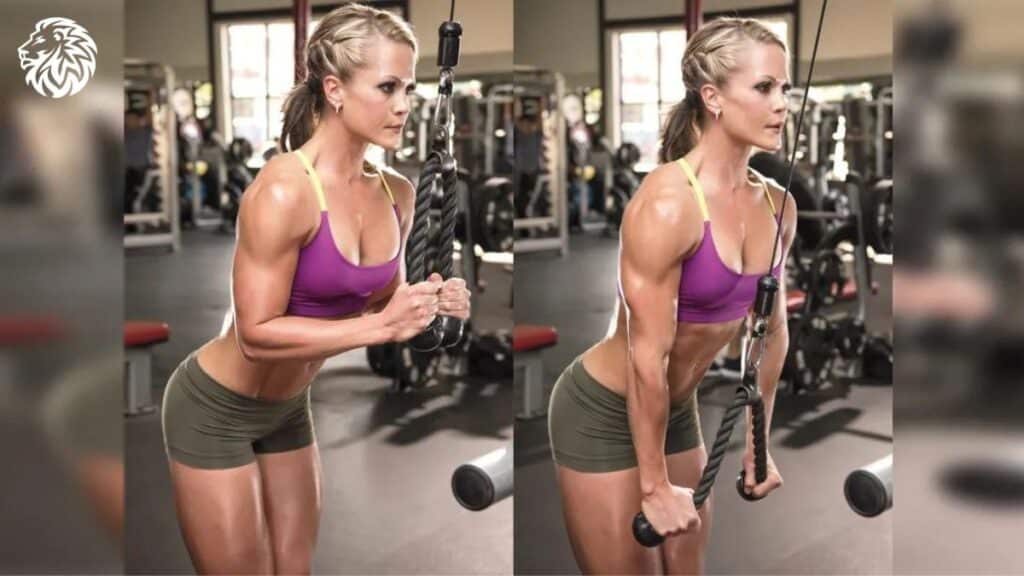
Technique and Grip Variations
The Rope Tricep Pushdown is a popular cable machine exercise for triceps.
- Standard Technique:
- Attach a rope to a high pulley of a cable station.
- Grip the rope with both hands and stand facing the machine.
- Lean forward slightly, keeping your back straight and elbows tucked at your sides.
- Push the rope down by extending your arms until they are fully straight.
- Slowly return to the starting position, maintaining tension on the triceps.
- Grip Variations:
- Neutral Grip: This is the standard grip with palms facing each other.
- Pronated Grip: Attach a straight bar instead of a rope. Grip the bar with palms facing down.
- Supinated Grip: Use a straight bar with palms facing up. This variation puts more emphasis on the medial head of the triceps.
Incorporating into Workout Routines
- As a Finisher: Rope Tricep Pushdowns are excellent for finishing a triceps workout, as they effectively isolate and pump the muscles after heavier compound exercises.
- Superset with Biceps Exercise: To balance your arm workout, superset Rope Pushdowns with a biceps exercise like curls. This approach ensures an efficient and balanced arm training session.
- Part of Upper Body or Push Day: Include this exercise in your upper body or push day (chest, shoulders, and triceps) routine.
- Frequency: Triceps can be trained 2-3 times a week depending on your overall workout split and intensity. Ensure to allow sufficient recovery time between sessions for muscle growth.
The Rope Tricep Pushdown is versatile and can be easily adjusted for different fitness levels by changing the weight. Its effectiveness lies in its ability to isolate the triceps, making it a staple in many arm and upper body workout routines.
Exercise 7: Tricep Kickbacks
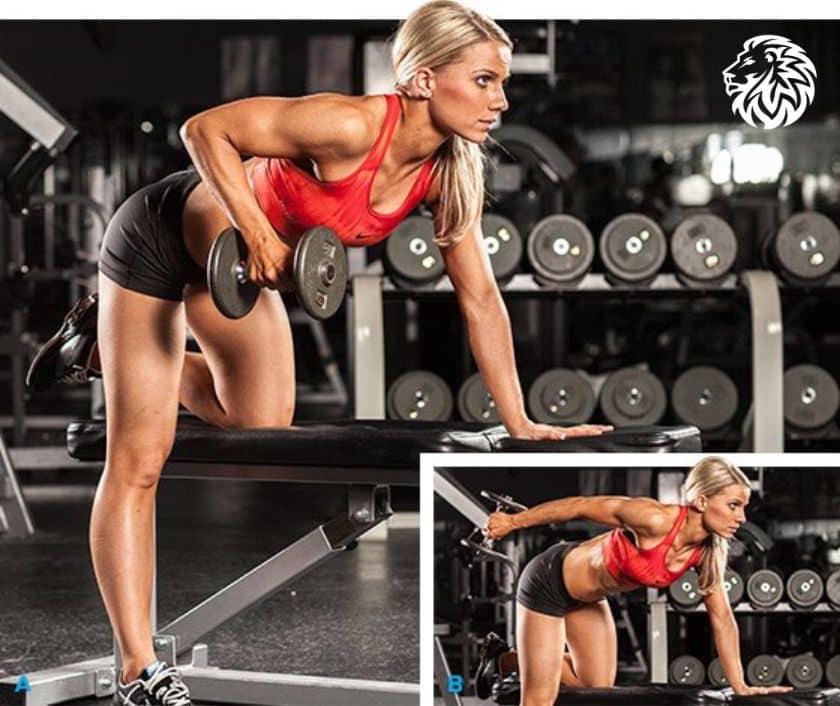
Detailed Execution Steps
Tricep Kickbacks are a focused isolation exercise that targets the triceps effectively.
- Starting Position:
- Stand with feet shoulder-width apart. Hold a dumbbell in each hand.
- Hinge forward at the hips, keeping your back straight. Bend your elbows so your upper arms are parallel to the floor.
- Execution:
- Keeping your upper arms stationary, extend your elbows to push the dumbbells back until your arms are fully extended.
- Pause briefly at the top of the movement, squeezing your triceps.
- Slowly return to the starting position, maintaining control throughout the movement.
- Breathing:
- Exhale as you extend your arms and inhale when returning to the starting position.
Tips for Maximizing Effectiveness
- Maintain Proper Form: Avoid swinging the weights or using momentum. The movement should be controlled, focusing on the triceps doing the work.
- Elbow Position: Keep your elbows tucked in close to your body and avoid moving your upper arms during the exercise. This ensures maximum engagement of the triceps.
- Range of Motion: Fully extend your arms at the top of the movement to achieve a complete triceps contraction.
- Weight Selection: Use a weight that allows you to perform the exercise with proper form but is challenging enough to fatigue your muscles by the end of your set.
- Mind-Muscle Connection: Focus on the triceps muscle throughout the exercise. This mental focus can enhance muscle activation and effectiveness.
- Progressive Overload: Gradually increase the weight or reps over time to continue challenging your triceps and to promote muscle growth.
Tricep Kickbacks are a great exercise for defining and strengthening the triceps. They can be easily included in any arm, upper body, or full-body workout routine, and are particularly effective for targeting the smaller muscle fibers in the triceps that might be less activated in other exercises.
Exercise 8: Single-Arm Tricep Extension
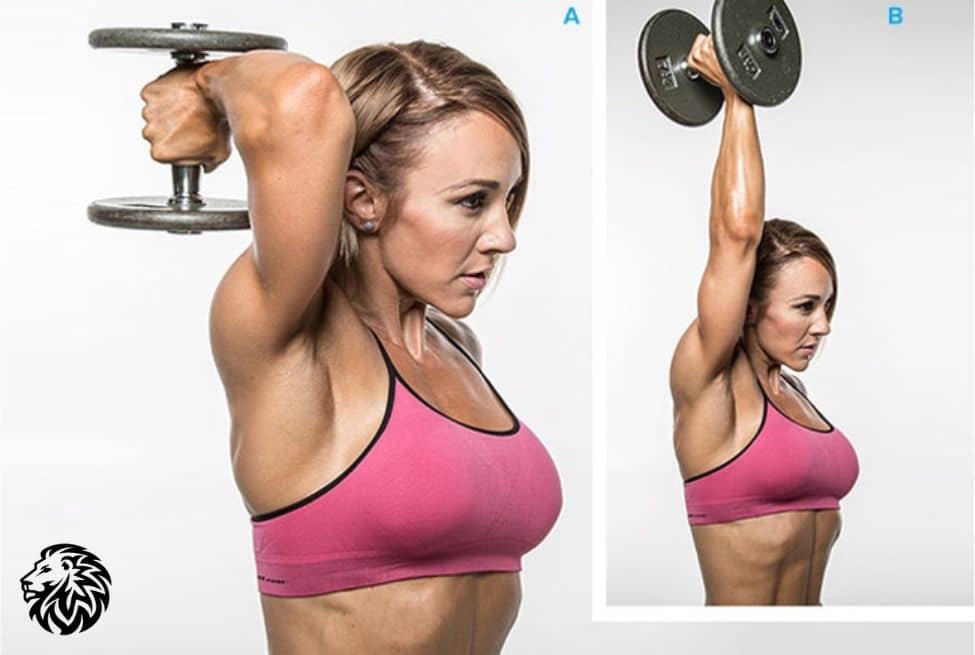
Performing with Proper Form
The Single-Arm Tricep Extension is an effective exercise for isolating each tricep individually.
- Starting Position:
- Hold a dumbbell in one hand and stand up straight or sit on a bench with back support.
- Raise the dumbbell overhead, fully extending your arm. Your palm should face inward.
- Execution:
- Keeping your upper arm still, bend your elbow to lower the dumbbell behind your head. Your forearm should move, but your upper arm should remain stationary and close to your head.
- Lower the dumbbell until your arm forms at least a 90-degree angle at the elbow.
- Contract your tricep to extend your arm and return the dumbbell to the starting position.
- Breathing:
- Inhale as you lower the dumbbell and exhale during the extension phase.
- Stance:
- If standing, keep your feet shoulder-width apart for stability. Engage your core throughout the movement.
Benefits of Unilateral Training
- Balance Muscle Development: Single-arm exercises help in correcting muscle imbalances by allowing each arm to work independently.
- Improved Muscle Focus: By isolating one arm at a time, you can concentrate better on the muscle contraction and form, leading to more effective workouts.
- Enhanced Core Engagement: Unilateral exercises require more core stability, as you have to counterbalance the weight on one side, thus indirectly working your core muscles.
- Increased Range of Motion: Working one arm at a time often allows for a greater range of motion, which can lead to better muscle development and flexibility.
- Adaptability for Injury Recovery: For those recovering from an injury on one side, single-arm exercises allow for continued training and strength maintenance on the uninjured side.
Single-Arm Tricep Extensions are particularly beneficial for those looking to enhance muscular symmetry and focus on individual muscle development. This exercise can be incorporated into arm-focused workout days or as part of a broader upper-body routine.
Exercise 9: Tricep Bench Dip
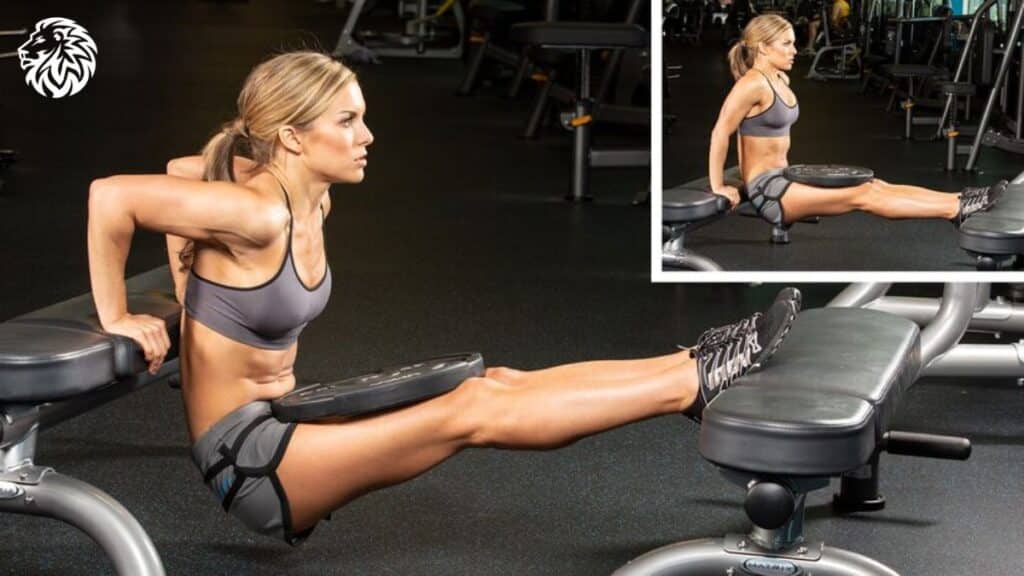
Guide to Form and Execution
Tricep Bench Dips are a practical exercise that can be performed almost anywhere, using just a bench or sturdy chair.
- Starting Position:
- Sit on the edge of a bench or chair. Place your hands next to your hips, fingers gripping the edge.
- Move your feet out and position your body off the bench, supporting your weight with your arms.
- Execution:
- Lower your body by bending your elbows until they form about a 90-degree angle. Keep your elbows pointed backward and close to your body.
- Push through your palms to lift your body back to the starting position. Focus on using your triceps to perform the lift.
- Posture:
- Keep your back close to the bench throughout the movement. Avoid hunching your shoulders.
Adjustments for Intensity
- Feet Position:
- Easier: Bend your knees, keeping your feet flat on the ground. This reduces the weight your arms have to lift.
- Harder: Extend your legs fully, placing your heels on the ground. The straighter your legs, the more challenging the exercise becomes.
- Adding Weight:
- For increased intensity, you can place a weight plate on your lap. Ensure the weight is secure and doesn’t slide off.
- Elevating Feet:
- Place your feet on another bench or raised platform opposite to your hands. This elevation increases the difficulty level.
- Tempo Variations:
- Slow down the lowering phase and/or add a pause at the bottom for increased muscle tension.
Tricep Bench Dips are a versatile exercise, ideal for both beginners and advanced individuals. By adjusting your feet position and adding weights, you can easily modify the intensity to match your fitness level. This exercise is excellent for targeting the triceps, enhancing arm strength, and can be incorporated into various upper body and circuit workouts.
Exercise 10: Triceps Machine Dip
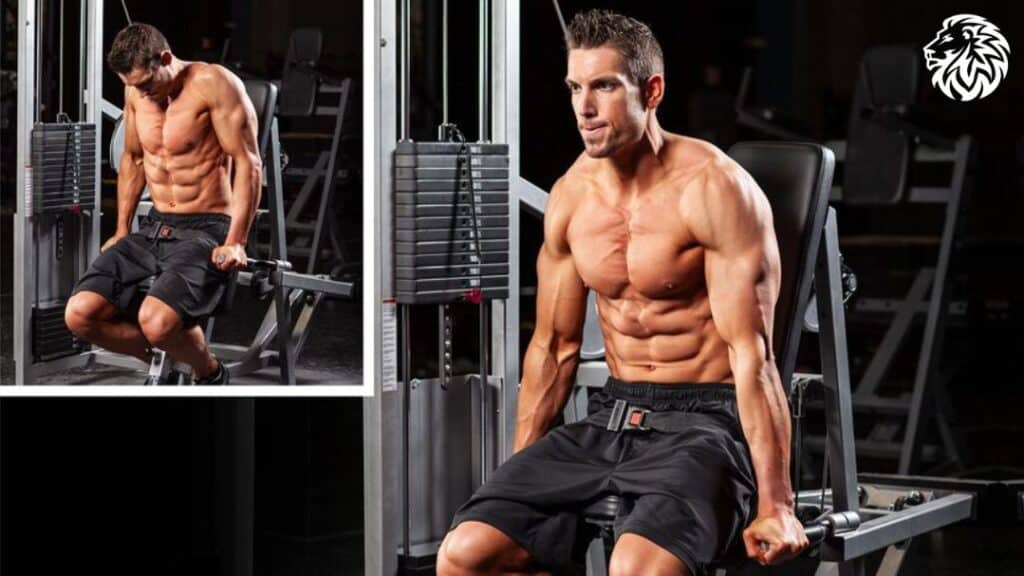
Step-by-Step Guide
- Adjust the Machine: Start by adjusting the seat height of the dip machine so that your arms are level with the handles when seated.
- Position Yourself: Sit down on the machine and grip the handles. Your palms should be facing inward, and your elbows should be close to your body.
- Start Position: Begin with your arms bent at a 90-degree angle, keeping your back straight and your chest up.
- Press Down: Exhale and push down on the handles, extending your arms fully. Focus on using your triceps to perform the movement.
- Pause and Return: Once your arms are fully extended, pause for a moment, then slowly return to the starting position while inhaling.
- Repeat: Perform your desired number of repetitions.
Tips for Maximizing Effectiveness
- Keep Elbows In: Ensure your elbows remain close to your body throughout the exercise to engage your triceps effectively.
- Controlled Movements: Focus on slow, controlled movements rather than using momentum. This increases muscle engagement.
- Mind-Muscle Connection: Concentrate on your triceps throughout the exercise. Visualize them contracting and extending with each repetition.
- Avoid Locking Elbows: When extending your arms, avoid locking your elbows at the bottom of the movement to keep tension on the triceps.
- Adjust the Weight: Use a weight that allows you to perform the exercise with good form but is challenging enough to fatigue your muscles by the end of your set.
Tips for Triceps Training

Frequency and Volume Considerations
- Training Frequency:
- Triceps can be trained 2-3 times a week, depending on your overall workout routine and goals. Since they’re involved in many pushing exercises, they often get indirect work on chest and shoulder days.
- Ensure to space out triceps workouts to allow for muscle recovery. For example, if you train triceps on Monday, wait until at least Wednesday or Thursday to target them again.
- Volume:
- Volume (sets and reps) depends on your training level and goals. Beginners may start with 3 sets of 8-12 reps per exercise, while more advanced lifters might do 4-5 sets.
- Focus on quality over quantity. Performing too many sets with poor form can lead to diminished returns and increased injury risk.
Importance of Rest and Recovery
- Rest Between Sets:
- Allow 30-90 seconds of rest between sets. Shorter rest periods can increase intensity and endurance, while longer rests are beneficial for recovery during strength-focused workouts.
- Recovery Days:
- Incorporate rest days into your training schedule to allow muscles to repair and grow. Triceps need time to recover just like any other muscle group.
- Sleep and Nutrition:
- Adequate sleep and proper nutrition are crucial. They play a significant role in muscle recovery and growth. Ensure a balanced diet rich in protein, healthy fats, and carbohydrates.
- Active Recovery:
- Engage in light activities like walking, yoga, or stretching on recovery days. This can help improve blood circulation and aid in muscle recovery.
By considering these frequency, volume, and recovery tips, you can optimize your triceps training for better strength gains and muscle development. Remember, consistent and balanced workouts paired with proper rest and nutrition are key to effective muscle building.
Conclusion
Recap of Key Points
- Diverse Exercises: We’ve explored a variety of triceps exercises, each targeting the muscle from different angles. Incorporating exercises like Close-Grip Bench Press, Tricep Dips, Skull Crushers, Overhead Tricep Extensions, and others ensures comprehensive development.
- Technique and Safety: Emphasizing proper form and technique is crucial for maximizing triceps growth and minimizing injury risks. Adjustments and modifications of each exercise allow for progression and adaptability to different fitness levels.
- Training Frequency and Volume: Balancing the frequency and volume of triceps training is essential. Training triceps 2-3 times a week with appropriate rest periods aids in optimal muscle growth and recovery.
- Rest and Recovery: Adequate rest between sets and recovery days, coupled with proper sleep and nutrition, are pivotal in supporting muscle growth and overall training effectiveness.
Encouraging Consistent Practice for Results
Building strong, well-defined triceps requires consistency and dedication. Regularly incorporating these exercises into your workout regimen, while paying attention to form, frequency, and recovery, will lead to noticeable improvements in strength and muscle tone. Remember, progress in muscle building is a gradual process, and consistent efforts will yield results over time. Stay motivated, track your progress, and don’t hesitate to adjust your routines as you grow stronger and more experienced. With perseverance and dedication, achieving your triceps development goals is well within reach.
References and Further Reading
- Spruce, M. (n.d.). Most effective triceps exercises. Verywell Fit. Retrieved from https://www.verywellfit.com/most-effective-triceps-exercises-1231027
- Bodybuilding.com. (n.d.). The 10 best muscle-building triceps exercises! Bodybuilding.com. Retrieved from https://www.bodybuilding.com/content/the-10-best-muscle-building-triceps-exercises.html
- Men’s Health. (n.d.). The best tricep workouts and exercises for men. Men’s Health. Retrieved from https://www.menshealth.com/fitness/g19547150/best-tricep-workouts/
- Men’s Journal. (n.d.). 15 best tricep exercises and workouts of all time. Men’s Journal. Retrieved from https://www.mensjournal.com/health-fitness/15-best-tricep-exercises-and-workouts-of-all-time-mens-journal
- SELF. (n.d.). The best triceps exercises. SELF. Retrieved from https://www.self.com/gallery/best-triceps-exercises
- Muscle & Strength. (n.d.). Triceps exercises. Muscle and Strength. Retrieved from https://www.muscleandstrength.com/exercises/triceps
- Everyday Health. (n.d.). Top exercises for stronger triceps. Everyday Health. Retrieved from https://www.everydayhealth.com/fitness/top-exercises-for-stronger-triceps/

